Tis the season for predictions no matter how ludicrous they may seem. After seeing numerous articles on the predictions of Nostradamus and Baba Vanga, I thought I would throw my hat into the ring as well. Here is a link on Baba Vanga as I know you want to find out more.
So, just how ludicrous is my bold prediction? Well, I am going to let you in on a little secret, like all mainstream (and alternative) media, my aim was simply to get you to notice the headline.
As I have written several times, the purpose of most media today is to simply get your attention. They need your attention in order to get paid by the advertisers and the best way to do that is to use outlandish headlines or cause you to become worried or outraged.
Over the past two years how many times have we seen headlines signalling the demise of everything we hold dear. As a case in point, on 21 December 2021 we had all forms of media telling us that Omicron cases would hit 200,000 per day! That makes a great headline and yes, we are giving it a red hot go!
But let’s put it into perspective, that means every man, woman and child in Australia may have contracted Omicron in the next 130 days. Now, assuming that you have some natural resilience to the virus post contraction, we would be out of the danger zone as there would be no one else left to infect, especially since we are not letting in any more back packers at the moment.
Upon closer inspection of the Doherty report that predicted the 200,000 cases per day, we find that this was the outlier prediction in a range of outcomes modelled and is dependent upon there being little to no restrictions and limited take up of booster shots. Living in Melbourne, the longest locked down city in the world, I find the chances of having no restrictions fairly farfetched.
Now getting back to my ludicrously bold market prediction, the keen eyed among you will have spotted that there is no date as to when the S&P/ASX 200 will hit that number. Over the past 30 years, the S&P/ASX 200 index has returned an average 9.7% per annum so using that average and a target date of 31 December 2030 we are able to arrive at my bold prediction of 15,613.3 perhaps not such a bold prediction on that time scale!
Before any lawyers get anxious about this, and we have a number as clients, let me stress that there is no guarantee that the S&P/ASX 200 will generate an average return of 9.7% per annum for the next 8 years. This is for illustrative purposes only. I can honestly say that I have no idea what return the market will generate next year, but I can make an assumption on which direction it is headed based on numerous inputs.
Before delving into what 2022 may hold in store for us, let’s reflect on what 2021 delivered and I promise not to mention Covid or lockdowns again.
2021 – Another unforgettable year!
It is fair to say that we have all experienced a range of emotions from fear to rage, and those emotions are still swirling in our community, but I think the main lesson learnt by most of us was to appreciate the simple things in life. Spending time with family and friends, when able to, is not to be underestimated in how much joy it brings to our lives.
On the political front, the most dramatic change was the inauguration of US President Biden and the subsequent storming of the US Capitol in Washington by Trump supporters. Such political divide was not just contained to the US as we witnessed our own state premiers implement a strategy of dividing our nation, albeit without the storming of parliament house.
The economic impacts of the pandemic continued to be felt by all, whether it be job losses and failed businesses or simply having to continue working from home and facing shortages of goods. Perversely, the investment markets shook all the concerns off and provided solid returns as noted in the table below.
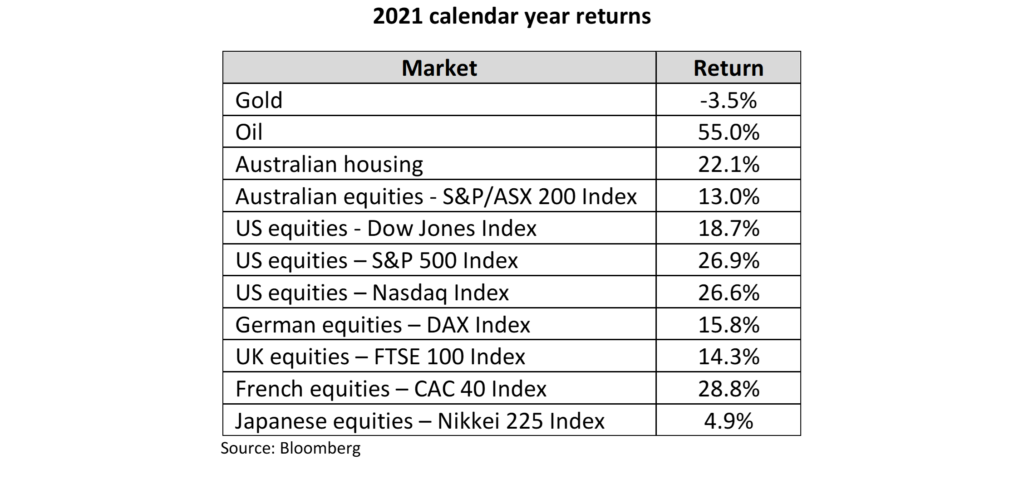
Perhaps driven by these strong returns, the Schroders 2021 Global Investor Study found that Australian investors expect an average return of 10.5% p.a. over the next 5 years. The S&P 500 hit record highs 70 times during 2021 and with some of the changing economic impacts discussed in the next section, it will be very difficult to replicate these returns in 2022. It appears that Australian investors are setting themselves up for future disappointment.
Themes to play out in 2022
Inflation
Due to the monetary support from governments and central banks there has been no lack of consumer and business demand, the issues we have faced have been supply related. Most of these issues stem from a lack of workers or components because they can’t be produced or delivered. This has created an inflationary issue that many central banks see as a temporary problem.
The problem for central banks is that this is an unprecedented problem in modern times, and nobody has a clear idea of how ‘temporary’ these inflation issues will be.
The following chart from breaks US inflation into two component parts – sticky inflation such as housing rents, insurance costs and medical expenses and flexible inflation which is things like food, energy, car costs and other discretionary spending.

Source: Capital Group – November 2021
As the chart shows, the rise in inflation to date has primarily been driven by flexible inflation as consumers spend their stimulus money. This inflationary pressure is expected to recede once the supply side problems fade and stimulus funds stop. The key difference to the 1970’s period is that sticky inflation has not yet taken off and this will be a key factor to watch in 2022.
Assuming that any new variants of Covid follow in a similar vein to Omicron and remain less severe in the medical impacts, global supply chains should start to return to normal by the end of 2022.
It is also worth reiterating that some inflation is not necessarily a bad thing for investment market returns. As the chart (also from Capital Group) below highlights, market returns typically turn negative when rolling inflation exceeds 6% p.a. or falls below 0% and at the moment, the US is in the 4% to 6% range.
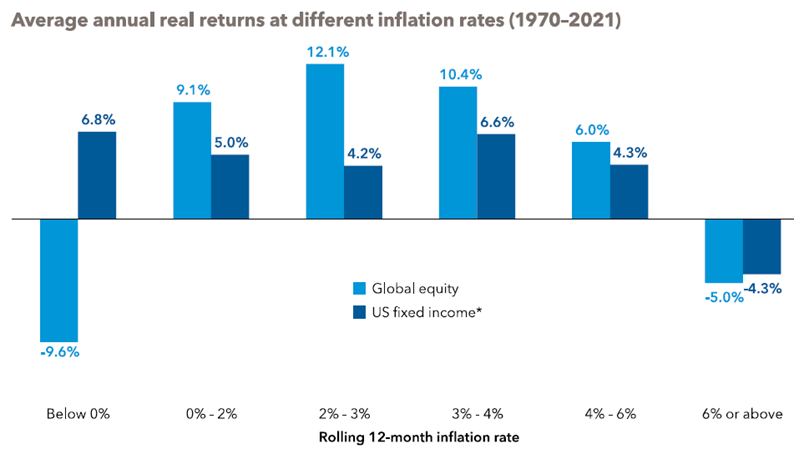
Source: Capital Group
No doubt, inflation will remain in the media spotlight throughout 2022 and will be stubbornly high until easing back down towards the end of the year.
Interest rates
Over the course of 2021 members of the US Federal Reserve changed their minds on when interest rates are likely to increase rather dramatically. In March, 14 of the 18 members expected no change to interest rates in 2022 and by December all 18 members expect at least 1 rate hike and the consensus is that there will be 3 hikes possibly starting in March 2022.
While central banks are not panicked by inflationary pressures at the moment, they do acknowledge that the stimulus measures are feeding into the inflation story. Central banks in the UK, US, Europe and Australia have all announced that they will be reducing or ceasing their stimulus bond buying signalling the end of easy money and the UK has already enacted a rate increase of 0.15% in December.
The Reserve Bank of Australia has announced that it still does not expect any rate increases until 2023 and the Europeans are unlikely to lift rates until at least the end of 2022. Irrespective of the official moves, banks are moving independently and have already started lifting fixed rates.
With consumer, business and government debt levels so high, any official interest rate moves are likely to be minimal as small increases will have their impacts magnified by the debt levels. Central banks will also remain cautious about killing off economic growth.
The difficulty for investment markets will be gauging how high interest rates are likely to climb and the impact that it will have on equity market valuations and bond prices. While bonds are negatively impacted by interest rate increases thanks to something referred to as the duration effect and potentially increasing credit spreads, they will remain a valid safeguard for all portfolios.
A trivia question for you all – When was the last time that the RBA increased the official cash rate? The answer is at the end of this update.
Valuations
The historically low interest rates we have witnessed have pushed all asset prices higher as investors chase yields in excess of cash rates. Valuations are elevated across the board, from stocks to bonds to real estate. Here in Australia, we have witnessed dramatic rises in property prices while overseas we have seen equity markets reach new record highs.
At times such as these, static allocations to broad passive exposures are not advisable. The largest equity gains have been concentrated in mostly US based, internet related businesses or electric vehicle related companies. Our clients will know that we have favoured reducing portfolio exposure to US equities in favour of European and Emerging Markets primarily on valuation grounds. We may have made this call a bit early, but we still stand by it as indicated in the graphs below. The first shows the relative performance of US equities versus the MSCI World ex-US markets.
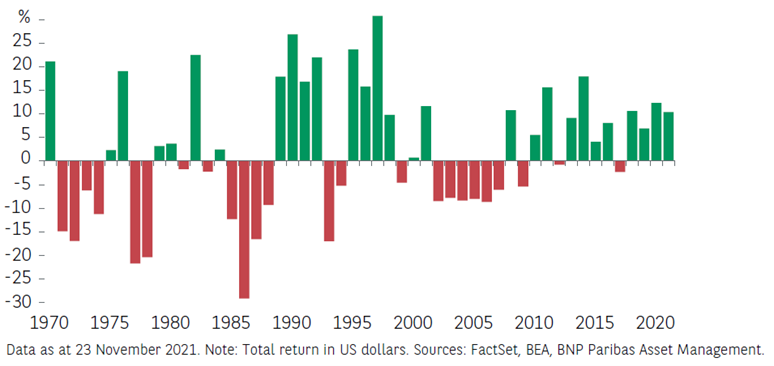
The green bars indicate years in which US equities outperformed global equities and it should be noted that since 1970 such outperformance has never run for more than 4 years in a row. 2022 could be the year in which global equities start to outperform once again.
The second chart also shows that global equities are priced at a discount on a price to earnings and price to book basis. Again, supporting our view that there are better opportunities to be had in global equities versus large US listed technology companies.
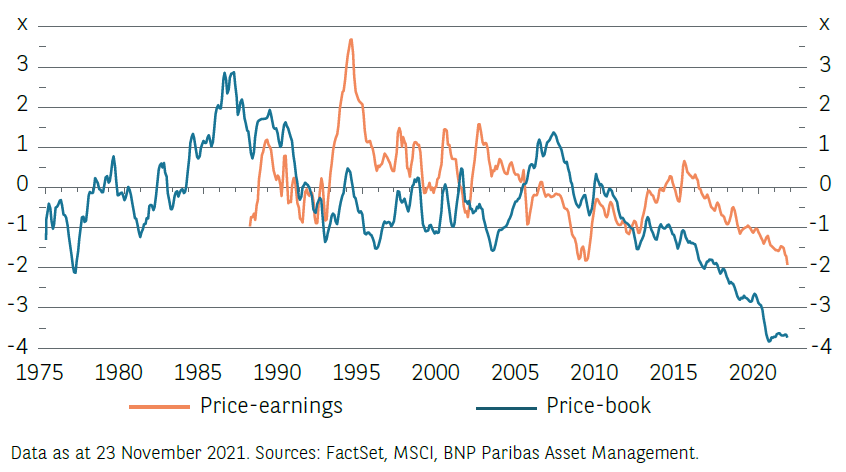
European equities are trading at 12-month forward Price to Earnings (PE) ratios of 15.3x versus 21.5x for US equities (S&P 500). Higher PE levels were justified by strong growth in profit margins, extremely low interest rates and the absence of inflation. Both interest rates and inflation have now started to turn so we should expect US PE levels to decline at some point.
A key factor to watch in January and February will be the US reporting season to see if labour and product shortages are impacting the very strong profit margins that most corporates have enjoyed to date. We also expect to see Chinese GDP and corporate profits to decline post the Winter Olympics and the 20th National Congress Meeting.
Politics
We face a federal election before 21 May 2022 so there will be major announcements about infrastructure spending and jobs creation. At this stage it is hard to try and determine a clear winner, last time Labour was almost guaranteed to win, only to fall over at the polls. Perhaps it’s just best to say that Australian politics is a mess at the moment and any impact upon investment markets will prove to be temporary.
In the US however, there is the chance of more significant political change. The US heads into its mid term elections in November and it looks likely that Biden will lose support of the House and possibly the Senate unless he can pull off a dramatic shift in voter sentiment.
If he loses either, it makes it far more difficult to push policy changes through as the Republicans will look to extract revenge on what they see as a stolen election and that means domestic policy will go nowhere for another two years.
As the chart below shows, US equity markets generally underperform in mid-term election years right up until the election itself before rallying once the outcome is known. I am not sure we will get such a late year rally this time as the political alternative is the possible return of Trump and all the volatility that he brings. This chart also adds support to our underweight US equity call.
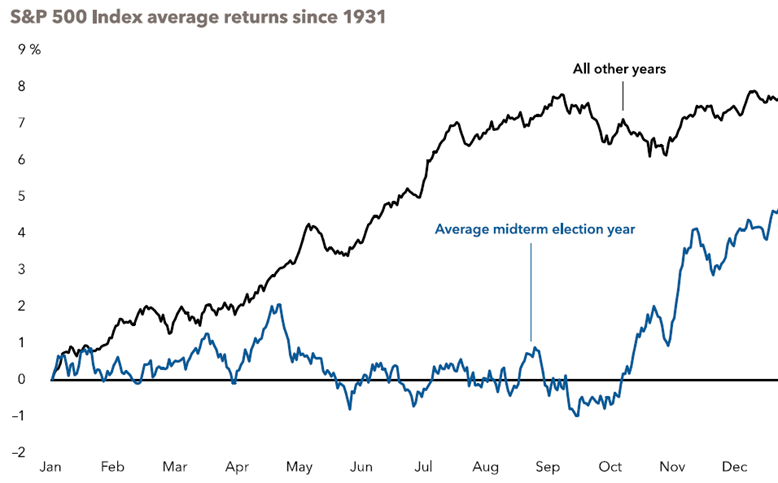
ESG investing
Our last thematic but perhaps the strongest one for 2022 is ESG investing. In 2015, world leaders developed 17 Sustainable Development Goals as part of the 2030 Agenda for Sustainable Development. The SDGs set forth a blueprint for fostering a healthy planet and an equitable society – both critical for a healthy economy.
Achieving the SDGs and the Paris accord will require trillions of dollars to be spent on infrastructure and new technologies. While some underlying ESG related investments generally underperformed the broader market in 2021 due to inflation and interest rate concerns about the impact on valuations of long-term assets, there is no doubt that money will continue to flow into this sector.
We continue to favour an exposure to ESG for the impact changes that it can have on our and our children’s lives alongside simply following the flow of money. Interest in this space has increased dramatically in the last two years, a flow on effect of the impact of Covid and people’s push back to a simpler, cleaner lifestyle. Where the money flows, opportunities abound, and we will continue to utilise specialised fund managers who can decipher those opportunities.
Final thoughts
For the reasons discussed above and many more, 2022 will yet again be a year of volatility but we are unlikely to see another recession as central banks will be wary of killing of economic growth and will stand ready with yet more stimulus if needed. Within volatility lies opportunity.
As growth assets continue to climb and interest rates rise, it is wise to take some profits and reallocate the funds to cash and fixed interest. We continue to believe that growth assets will outperform but it is a bit like blowing up a balloon, the more air you put into it the more it stretches and sooner or later it bursts in your face.
By taking some profits as you go and allocating to more defensive investments, we can take advantage of that balloon popping by stepping in and picking up quality assets at clearance prices. Losses from bond markets tend to be minimal in these times, compared to possible losses from equity corrections.
We also expect people will focus on their core values and goals in a post Covid world and for that reason we have partnered with Lumiant which is a values-based software programme that helps identify what really matters to you. We will continue discussing this with our clients throughout 2022.
We are not in the business of making bold predictions in the hope of selling some product, we are here to help guide our clients towards achieving the financial future that they want. We are a truly independent firm solely focused on helping our clients. What we do offer is wisdom. Having been in this industry for over 20 years helping clients build wealth we have witnessed the mistakes made and successes achieved many times, and that allows us to draw upon that bank of knowledge when working with you.
Finally, I wish to say a big thank you to all of our clients. We had a very successful year and our business continues to grow thanks to the many referrals that we receive from you. We are always happy to talk to those who are important in your lives and promise that after a free initial, no obligation discussion we will ensure that they are in a better position than if they hadn’t had a chat with us.
And the answer to the trivia question of when the RBA last lifted the official cash rate – 3 November 2010. Yes, that surprised me as well, it does not seem like it was 11 years ago. What an incredible period we have lived through.
Andrew Aylward is Chief Investment Officer at Keep Wealth Partners.
Keep Wealth Partners Pty Ltd (AFSL 494858). This information is of a general nature only and may not be relevant to your particular circumstances. The circumstances of each investor are different, and you should seek advice from a financial planner who can consider if the strategies and products are right for you.







